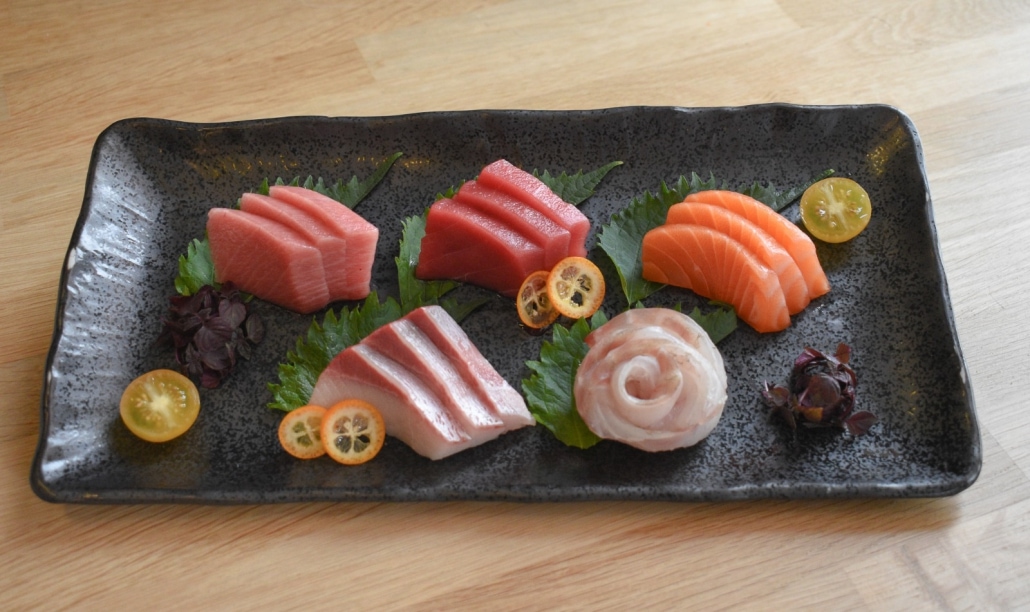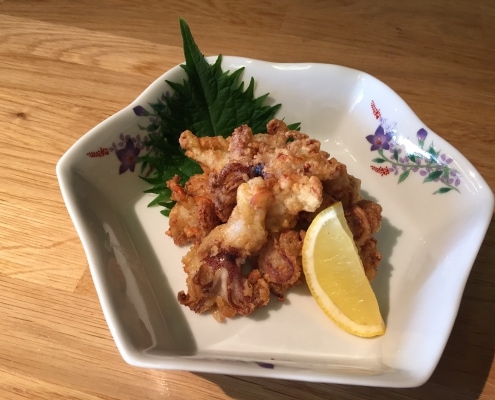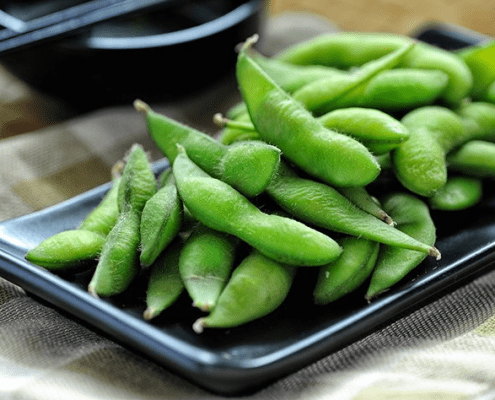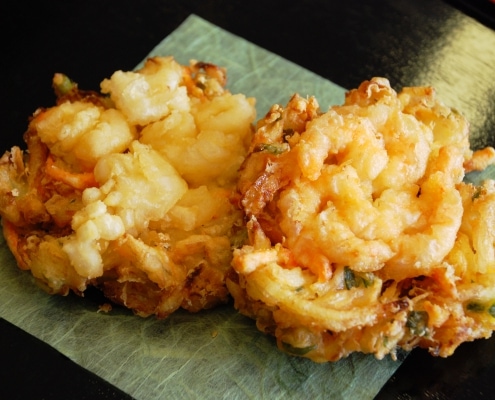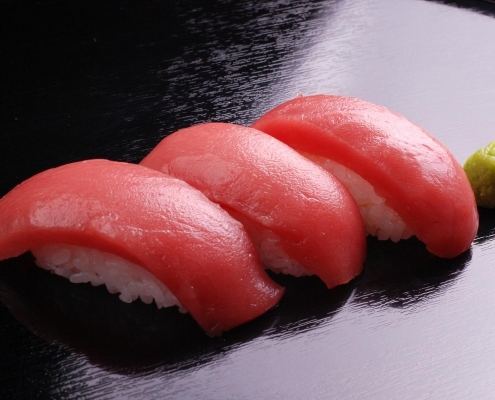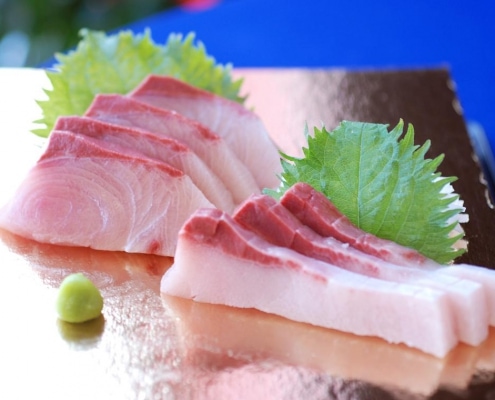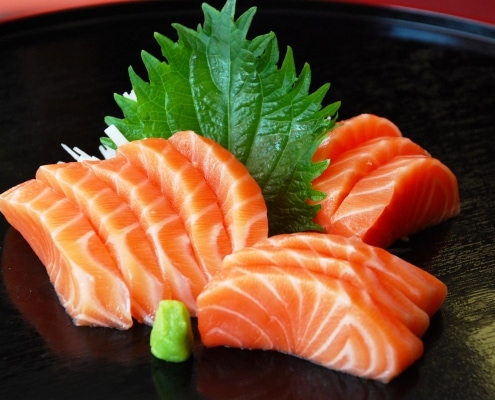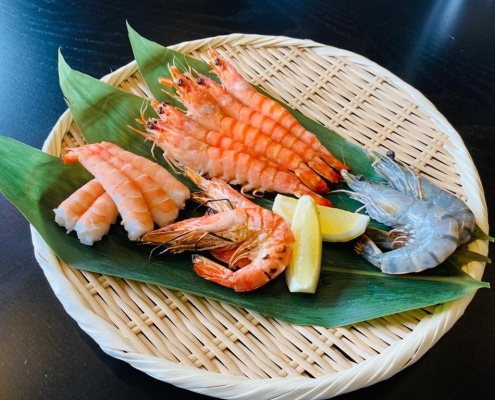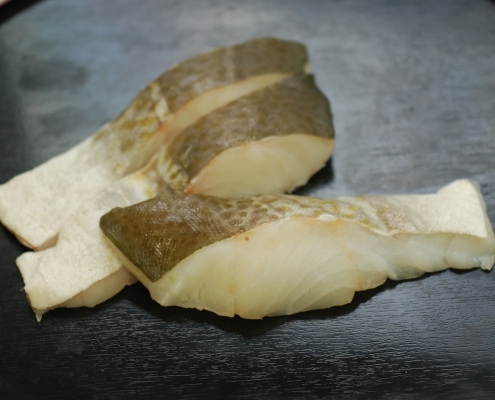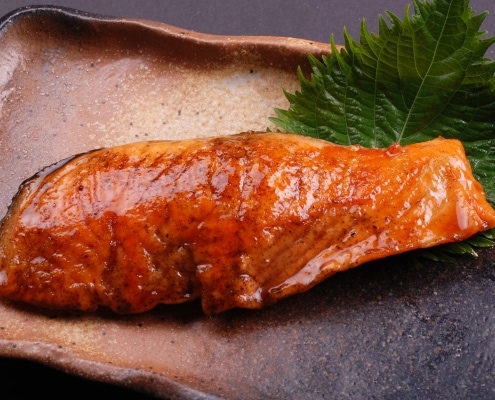Happy Holidays!
Here you can find all the recipes for a festive dinner. Meshiagare!
Snack Platter
- Remove the Kakiage from the package and put in the microwave for 1 minute (or leave on the counter for 10-15 minutes) to soften it.
- Put the Kakiage and Ika Geso Karaage (thawing is not necessary) in the fryer at 180 ℃.
- Remove the Kakiage after 2-3 minutes and the Kakiage after 4-5 minutes.
- Drain the fried snacks on a piece of kitchen paper.
- Meanwhile, place a small pan of water and bring it to boil. Add the Edamame to the boiling water and cook for about 3-5 minutes.
- Prepare the sauces. A small bowl of (Japanese) mayonnaise for the Ika Geso Karaage, some extra salt for over the Edamame and a homemade sauce for the Kakiage: mix 120 ml hot water with 1 gr dashi powder, 20 ml soy sauce, 20 ml mirin, 4 gr sugar and 3 gr grated ginger.
- Place the snacks on a platter and enjoy!
Sashimi dish
- Defrost the Maguro Chu Toro, Buri Sashimi and Sake sashimi in cold water for half an hour.
- Remove the package and dry the fish with kitchen paper.
- Cut the raw Tuna, Buri and Saslmon in slices. Click here to see how chef Ohtawara cuts sashimi.
- Complete the sashimi dish with our chef’s sashimi sauces.
- Put the slices of sashimi on a nice plate and pour the sauce on top. Enjoy your meal!
Chef Kuniyoshi Ohtawara shows how to make the traditional Japanese main course Nabe (hotpot)!
Preparation method: Nabe
- Put 1 liter of water and 5 grams of kombu in a pan and bring to a boil.
- Carefully place the vegetables in the pan in a nice order. Tip: start with carrots and other hard vegetables that take longer to cook.
- Add the fish and follow the same tip as step 2. Start with fish like Start with fish such as Ebi, Sake no Kirimi and Tara no Kirimi that take longer to cook and add sashimi last.
- Let it cook for 5 to 10 minutes.
- Meanwhile, prepare the lemon ponzu and goma sauce.
Lemon ponzu: mix 200 ml soy sauce, 180 ml lemon juice, 90 ml boiled mirin, 5 grams bonito flakes (optional) and 2 grams kombu (optional).
Goma sauce: mix 100 grams of tahini, 100 ml of boiled mirin, 50 ml of boiled sake and 100 ml of soy sauce. - Serve the nabe with the lemon ponzu and/or the goma sauce. Meshiagare!
Preparation method: Seafood Sukiyaki
- Heat 250 ml sake, 200 ml mirin, 150 ml soy sauce and 80 grams sugar in a pan on the stove.
- Carefully place the vegetables in the pan in a nice order. Tip: start with carrots and other hard vegetables that take longer to cook.
- Add the fish and follow the same tip as step 2. Start with fish like Start with fish such as Ebi, Sake no Kirimi and Tara no Kirimi that take longer to cook and add sashimi last.
- Add 100 ml water and let it boil for 5 minutes. Meshiagare!
Ika Geso Karaage (Squid tentacle for deep fry)
Japanese people are known for not wasting any part of a product, which also applies to the squid. Fortunately, squid tentacles have beautiful white meat that is in fact very flavorsome. When deep-fried they make the perfect finger food to go with a cold beer.
Edamame (Japanese Soy Bean)
In our Japanese restaurant Hokkai Kitchen we have been serving Edamame for years. These Japanese Soy Beans are very popular in our restaurant and therefore we would like to offer them for home-use. Delicious in a salad, pokébowl or as a snack.
Kakiage (Tempura)
Kakiage is a popular Japanese tempura dish that consists of thinly cut vegetables and seafood. All ingredients are coated with some tempura batter and then deep fried. We recommend eating these perfectly crispy and delicious snacks with some udon, tentsuyu, or simply with salt.
Maguro Chu Toro (Medium Fatty Tuna)
Chu Toro in Japanese means medium fatty tuna. It is located just below the skin and in the back of the tuna belly. Chu Toro is the perfect balance between the lean Maguro Akami and the softer Maguro O Toro. This elegant piece of tuna is perfect for sashimi and sushi, but it is also delicious as a steak.
Please pay attention: what makes blue fin tuna so delicious is its richness of fatty parts. This does however make it prone to discoloration. Because of this, tuna has a short “best before” date of about two weeks. Keep in mind that this is not the same as an “expiry” date, and even if a frozen piece of tuna changes color, this does not mean it cannot safely be consumed. You make it into “Zuke” (marinade). To make “Maguro no Zuke”, boil off the alcohol of some cooking mirin, and marinate the tuna for 15 minutes in a mixture of 3 parts soy sauce and 1 part cooking mirin.
Buri Sashimi (Kingfish Sashimi)
Buri (Yellowtail) is a greatly appreciated product in Japan. Our Buri is farmed in the waters of Japan itself and is very high fat. This product is perfect for sushi and sashimi. Our buri is highly sustainable.
Sake Sashimi (Salmon Sashimi)
Fresh frozen salmon with a smooth and rich taste. Perfect for sushi and sashimi.
Ebi (Shrimp)
Our shrimps have a firm structure and a delicious taste. Perfect for a creamy pasta, a summer salad or as a snack with a drink. From the shrimp heads, you can make a spicy broth for a bowl of warm soup.
Tara no Kirimi (Cod Slices)
Tara Kirimi simply means sliced cod. We have not added any flavor to it, so you can let your creativity run wild. Cod goes very well with butter and garlic, but simply grilling it with some salt and pepper is also delicious.
Sake no Kirimi (Salmon Slices)
We have not added any flavors to our salmon, so you can let your creativity run wild. It’s a comforting thought that the best dishes in Japan are cooked just by adding some salt. If you are a more experienced cook we advise you to try out some nice marinades.
Happy Holidays!
Have you made something tasty with the Holiday Fukubukuro? We would love to see your festive creations as a home cook on social media under the hashtag #hokkaiathome
